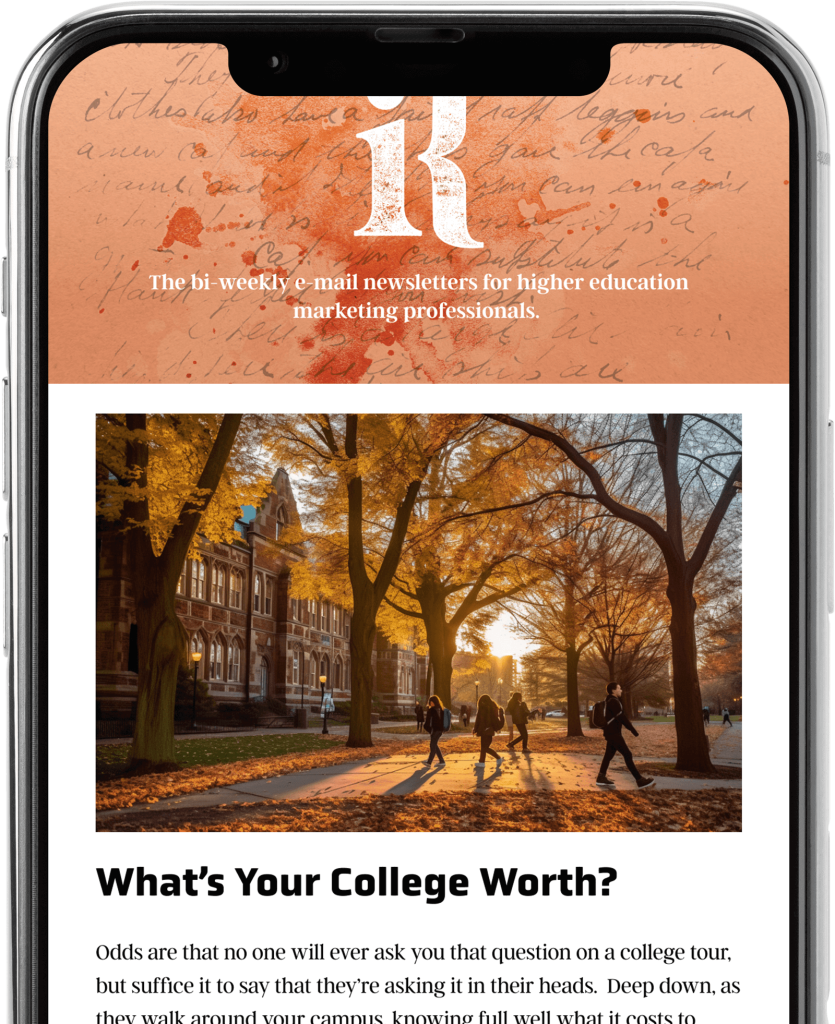Featured
Developing a Higher Ed Promotional Strategy

If there’s one thing we know about marketing it’s this: if we don’t build awareness we won’t have any customers. And while there are all sorts of ways to do that—ranging from public relations campaigns to referral programs, promotion (specifically, paid promotion) is one lever over which we have a high degree of control. As such, it gets a great deal of attention. You might recall from some earlier reading on the marketing mix (the 4 P’s) that I often like to remind people that there’s more to marketing than just promotion.
We commonly define promotion as the total of all activities and strategies used to communicate with our audience segments and influence their decisions. Said a bit more softly, promotion is the practice of reaching out to those we’re meant for with a message that’s meant for them.
When it comes to promotion, there are more avenues for a higher education marketing professional to utilize than we can count. But for the sake of context, here’s a list of some key areas of promotional activity:
- Traditional advertising – includes television commercials, print ads, radio spots, and outdoor placements.
- Public relations (PR) – includes media relations, awards, public events, and press announcements.
- Sales promotion – examples include discounts, contests, coupons, and special offers such as “buy one, get one free” (BOGO).
- Direct marketing – targeted campaigns such as direct mail, text messages, and e-mail.
- Personal selling – person-to-person interaction online, over the phone, or in-person.
- Digital marketing – using online platforms like social media and search engines to reach customers.
Tools used in the implementation of these segments evolve constantly. Not only are there new platforms emerging all the time, the platforms themselves change at a rapid pace. Each social media platform, for example, seems to be introducing new (and discontinuing existing) ad formats, pricing models, content restrictions, and engagement metrics at a pace that’s really difficult to keep up with. Search engines like Google present similar difficulties when it comes to understanding how to rank highly and how to get a single paid ad through the restrictions, filters, and verifications.
These changes and evolutions aren’t true just for digital promotions. When it comes to sales collateral, just think of how many paper styles, varnishes, and foils a higher education marketer gets to choose from. Or if you want to produce some swag, you can pretty much print your collegiate logo on anything. And there are new “anythings” coming out all of the time.
We won’t be able to address all of those issues here, honestly. There are too many of them and they change too rapidly. And frankly, I’m not so sure there where our attention should be. I’ll take a solid campaign theme on cheap paper over a lame campaign on expensive stock all day. But what we can do is address some of the core pillars of collegiate promotion, a checklist of sorts, for you to consider. So let’s examine some critical elements of an effective higher education promotional strategy:
- Values – does the promotional strategy as evidenced by the messaging reflect the core values of the institution?
- Positioning – does the promotional messaging give context to you audience segments?
- Persona-focused – do promotional activities reflect our right-fit-student?
- Rooted in institutional strategy – are our promotional assets in sync with our mission, vision, and overall strategic plan?
- Attribution – do we have a way of measuring our promotional activities in a way that helps us understand from which sources our best leads are originating?
- Rooted in the 80/20 principle – are our activities structured, measured, and adjusted in a way that recognizes the disproportionate relationship between inputs and outputs?
- Emotional connection – do the communications make the audience feel something?
- Storytelling – is there a connection to authentic stories reflective of your institution’s mission, vision, and values?
- Engagement – does the promotional campaign invite thoughtful engagement? Hint: a user simply liking an Instagram post doesn’t necessarily qualify.
- Framing ROI – does the promotional thinking involve a conversation about the value we deliver to our students?
- Avoids marketing myopia – does the messaging speak more to the service rendered or value delivered?
- Website copy – does the key copy on our home page, perhaps the most visible asset in our promotional strategy, reflect our overall strategy?
- Brand depth – does the promotion reflect our core brand associations as reflected by our institution’s brand vision?
- The three hurdles – does the promotional campaign overcome the three hurdles of differentiation, relevance to the audience, and an advantage that can be sustained over the long term?
Answering yes to these questions puts your institution on a path toward a solid promotional strategy that helps you to separate yourself confidently. Admittedly, it’s hard to answer affirmatively to all of these questions all of the time with each specific channel you might employ. That said, if you’re looking at this list and finding that your promotional tools aren’t reflecting most of these tenets most of the time, there are likely some strong opportunities to develop and improve your promotional strategy.
Like what you're reading?
Subscribe to our newsletter to get the latest insights in Higher Education and thought leadership.


